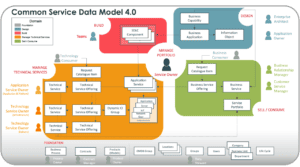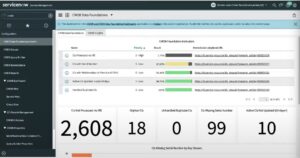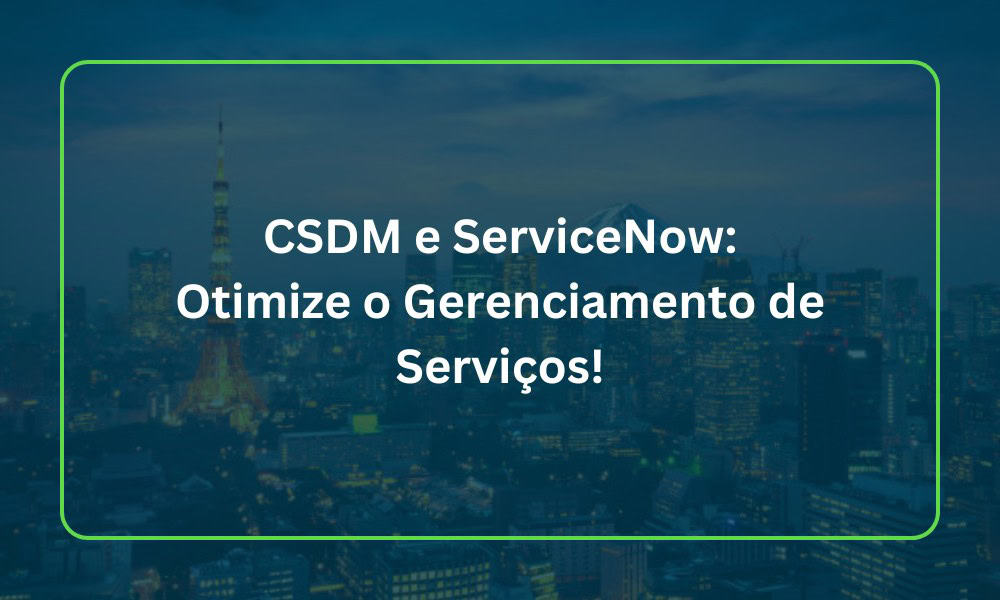The Common Service Data Model (CSDM) in ServiceNow is a standardized framework that helps organizations structure and manage their configuration items (CIs), CMDB (Configuration Management Database), and services within the ServiceNow platform. It provides a consistent way to define and relate different aspects of IT services and business services, enabling better visibility, management and reporting.
Main components of CSDM:

1. Foundation Data:
- Location: Physical locations where services are provided.
- User: People or groups who use the services.
- Company: Legal entities that own the services.
2. Design:
- Services Portfolio: Catalog of commercial and technical services.
- Business Service: Services provided to the company.
- Technical Service: IT services that support business services.
3. Manage Technical Services:
- Application Services: Grouping of ICs that deliver applications.
- Infrastructure Services: Grouping of ICs that deliver infrastructure.
4. Sell/Consume:
- Offers: Descriptions of services available to consumers.
- Service Catalog: Collection of offers available for request.
5. Manage Business Services:
- Business Capabilities: High-level skills that the organization needs.
- Business applications: Applications that support business features.
Benefits of CSDM:
- Improved Service Management: Provides a clear framework for managing services and CIs, improving the management of incidents, problems, changes and services.
- Improved reporting and analysis: Facilitates better reporting and analysis due to standardized data.
- Greater visibility: Provides better visibility into the relationships between services and their supporting infrastructure.
- Alignment with Best Practices: Aligns with ITIL and other industry best practices, ensuring a robust IT service management framework.
Implementing CSDM in ServiceNow:
- Evaluate current data: Evaluate existing data and its alignment with CSDM standards.
- Define the CSDM framework: Customize the CSDM framework to meet your organization's specific needs.
- Data migration and cleaning: Migrate existing data to the CSDM framework and clean up any inconsistencies.
- Ongoing governance: Establish governance processes to maintain data quality and compliance with CSDM standards.
By joining CSDM, organizations can gain a more organized and efficient approach to managing their IT and business services in ServiceNow.
The Common Service Data Model (CSDM) and Configuration Management Database (CMDB) in ServiceNow are closely related concepts that work together to improve IT service management. Here's a breakdown of how they interact and complement each other:
Configuration Management Database (CMDB):
CMDB is a repository that stores information about IT infrastructure, including details about configuration items (CIs) such as servers, applications, network devices, and relationships between them. It serves as a central source of truth for IT environments, providing visibility into the components that make up IT services.
Main features of CMDB:
- Centralized data storage: Aggregates data from multiple sources into a single repository.
- Relationship Mapping: Tracks dependencies and relationships between CIs.
- Change Management: Facilitates the analysis and management of the impact of changes through understanding CI interdependencies.
- Incident and Problem Management: Supports root cause analysis and resolution by providing detailed CI information.
- Compliance and Auditing: Ensures compliance with policies and regulations through detailed monitoring and reporting.
Main components of CSDM:
- Foundation Data: Basic elements such as locations, users and companies.
- Design: Structures business and technical services, service portfolios and relationships.
- Manage Technical Services: Focuses on application and infrastructure services.
- Sell/Consume: Includes service offers and catalogs.
- Manage business services: Defines business resources and applications.
How CSDM Enhances CMDB:

1. Standardization:
CSDM provides a consistent and standardized way to structure and relate CIs and services within the CMDB, ensuring that data is organized in a logical and comprehensive manner.
2. Improving data quality:
By following CSDM guidelines, organizations can improve the accuracy and completeness of CMDB data, leading to more reliable insights and decision-making.
3. Improved Visibility:
The CSDM framework makes it easy to visualize the relationships between business services, technical services, and the underlying infrastructure, increasing overall service visibility.
4. Better alignment with best practices:
CSDM aligns with ITIL and other best practices, helping organizations adhere to industry standards and improve their IT service management processes.
5. Reporting and Analysis Made Easy:
With a standardized data model, organizations can produce more consistent and meaningful reporting and analysis, leading to better performance tracking and management.
Implementing CSDM in CMDB:
1. Assessment and Planning:
Assess the current CMDB structure and data quality. Define a roadmap for adopting CSDM standards.
2. Data Model Customization:
Customize the CSDM framework to meet the organization's specific needs.
3. Data cleaning and migration:
Clean up existing CMDB data and migrate it to align with CSDM standards.
4. Ongoing maintenance:
Establish governance processes to ensure ongoing data quality and adherence to the CSDM framework.
Implementing CSDM on the ServiceNow platform is a journey that resembles a learning and growth path. You need to start with CSDM, take the first steps, understand the framework, and adapt the model to the needs of your organization. This initial phase, the “walk,” is crucial to establishing a solid foundation where data quality and standardization are priorities.
The next step, “run,” involves optimizing ITSM processes, integrating network devices, leveraging ServiceNow modules, and executing the run phase to improve operations management. In this phase, CSDM provides a clear view of the dependencies between configuration items (CIs) and services, facilitating impact analysis and root cause resolution. Using ServiceNow Discovery is crucial to populating the ServiceNow CMDB with accurate data.
The ultimate goal is to achieve “flying,” where the organization takes full advantage of the ServiceNow ecosystem by leveraging advanced tools to automate tasks, predict issues, and optimize workplace service delivery. Data visualization and data modeling become essential for strategic decision-making, enabling business and technical teams to work together to maximize the value of the platform.
CSDM and Digital Transformation
CSDM is a fundamental pillar in the digital transformation of organizations. It enables organizations to align their IT services with business goals, improve governance risk and compliance, and optimize strategic portfolio management. The CSDM model framework facilitates the integration of ServiceNow products such as Customer Service Management, Field Service Management, HR Service Delivery, and Cloud Management, creating a unified and efficient service environment. Business applications are best managed with CSDM in ServiceNow.
The Phased Approach
CSDM implementation should be done gradually, following a phased approach that prioritizes data quality and adapting the model to the organization's needs. It is important to define a clear roadmap, establish success metrics, and involve business and technical teams at every stage of the process. Data migration should be performed carefully to ensure the integrity of information objects. Implementing ServiceNow CSDM on ServiceNow instances should be done with planning.
The Importance of Governance
Governance is essential to ensuring the quality and consistency of data in the Configuration Management Database (CMDB). Clear processes must be established for creating, updating, and deleting configuration items, as well as for maintaining the CSDM framework structure. Governance is also critical to ensuring compliance with organizational policies and regulations. The leadership team must be involved to ensure the success of the ServiceNow implementation.
CSDM and the Future of Service Management
CSDM is a model that is constantly evolving, adapting to new technologies and market needs. The integration of new technologies promises to revolutionize the way organizations manage their IT services. CSDM will continue to be a fundamental pillar in the future of service management, helping organizations achieve their business goals and remain competitive in an increasingly digital world. Product engineering and management processes benefit from the effective use of CSDM in ServiceNow. The use of ootb tables and creator workflows allows for greater flexibility and automation. The person responsible for managing the configuration items CIS must have a deep knowledge of the CSDM framework. Business strategy is strongly influenced by the correct use of CSDM provides. Business capabilities and business processes are improved with the correct implementation of CSDM in ServiceNow. ServiceNow modules are better utilized with the correct implementation of CSDM in ServiceNow. Portfolio management is easier with CSDM in ServiceNow. ITSM management is more efficient with CSDM in ServiceNow. The ServiceNow ecosystem and ServiceNow platform are enhanced with CSDM.
Key points:
- CSDM in ServiceNow: Standardized framework for managing CIs, CMDB, and services.
- Improved Service Management: Improved visibility, reporting and analytics.
- Alignment with Best Practices: ITIL, COBIT and ISO 19770.
- Gradual Approach: Assessment, customization, migration and ongoing maintenance.
- Governance: Data quality and compliance.
- CSDM and the Future: Integration of new technologies and adaptation to market needs.
- ServiceNow ecosystem and ServiceNow platform are enhanced with CSDM.
Conclusion:
CSDM provides the model for structuring and managing data within the CMDB, increasing its effectiveness and usefulness. Together, they form a powerful combination that improves IT service management, increases visibility into IT environments, and aligns with industry best practices such as ITIL, COBIT, and ISO 19770


